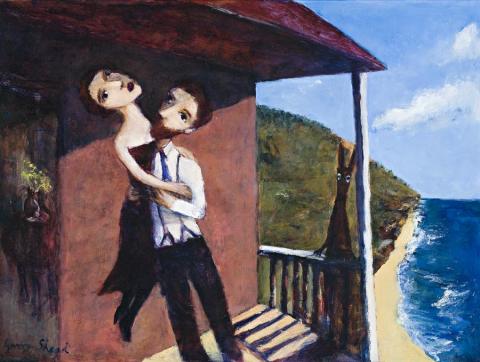AFTERNOON AT THIRROUL, 1996
GARRY SHEAD
oil on composition board
45.5 x 60.5 cm
signed lower left: Garry Shead
Private collection, Sydney
Goodmans Auctioneers, Sydney, 30 July 2003, lot 74 (as D.H. Lawrence Series)
Private collection, Sydney
'The only way to do justice to a man like Lawrence who gave so much, is to give another creation. Not explain him, but prove... that one has caught the flame he tried to pass on.'1
Having first discovered the work of D.H. Lawrence during a trip to New Guinea in 1968, Garry Shead immediately discerned significant affinities between his own experiences and those of the author who visited Australia in 1922. As Grishin elucidates, 'When Shead speaks of Lawrence the word'synchronicity' features frequently; he uses the word in the sense of the strange coincidences or correspondences... [A]t various forks in the road of his life, Lawrence crops up - when he was in New Guinea and decided he would marry Merril, he was reading Lawrence's letters; it was in Vence, where Lawrence died that he met his wife Judith... He introduced Whiteley to 'Wyewurk', Lawrence's cottage at Thirroul, and it was from the house next door... that they painted their diptych (Portrait of D.H. Lawrence 1973). Whiteley could also feel the presence of Lawrence hovering around the place; and it was at Thirroul that Whiteley died.'2
Although clearly unfolding upon the open verandah of Wyewurk, with the township of Thirroul and the steep escarpment beyond, Afternoon at Thirroul 1996 does not offer a literal depiction of a specific incident from Lawrence's Kangaroo but instead, is universal in connotation. Exploring themes of love and conflict, identity and alienation, the spiritual and the human, indeed the work encapsulates the artist's homage to D.H. Lawrence as 'a personal, intuitive response rather than an attempt to illustrate Lawrence's narrative.'3 Thus, the figures - presumably Richard Lovat Somers and his wife Harriet of the novel - appear strange and ambiguous, taking on the features of Lawrence and Frieda while at the same time, bearing more than a passing resemblance to Shead and his wife Judith. Similarly their main adversary, the omniscient Kangaroo here perched against the verandah railing, is ambivalent in his identity, representing more of a 'presence' than an identifiable character. A poetic scene - recognisably Australian yet strangely timeless and mythical - the work embodies well the drama and enormous sense of anticipation present in the novel where the reader remains '... waiting, waiting for something to happen, waiting for this spirit of the land to strike.'4
1. Miller, H., The World of D.H. Lawrence: A Passionate Appreciation, Capra Press, California, 1980.
2. Grishin, S., Garry Shead and the Erotic Muse, Fine Art Publishing, Sydney, 2001, p. 94
3. Grishin, S., Garry Shead and the D.H. Lawrence Paintings, Craftsman House, Sydney, 1993, p. 14
4. ibid.
VERONICA ANGELATOS
